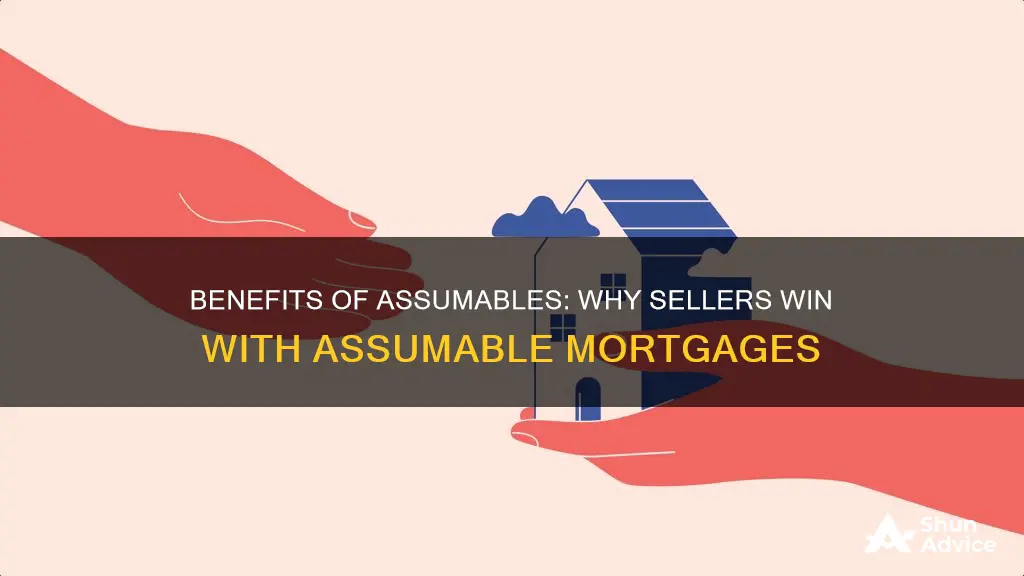
An assumable mortgage is when a buyer takes over the seller's home loan, allowing them to skip the rigorous process of obtaining a new home loan. This type of mortgage can be beneficial to the seller as it helps them avoid settlement costs and can be used as a marketing strategy to attract buyers. Assumable mortgages are more attractive to potential buyers when the seller's home equity is low, and they can lock in a lower interest rate than the current market rate. However, it is important to note that not all mortgages are assumable, and both the buyer and seller must meet specific requirements and receive approval from the lender and agency sponsoring the mortgage.
How does an assumable mortgage benefit the seller?
| Characteristics | Values |
|---|---|
| Simplified selling process | The seller can benefit from a simplified selling process, as the buyer assumes the seller's mortgage loan, including the repayment period and interest rate. |
| Attractive to buyers | Assumable mortgages can be attractive to buyers due to the potential for lower interest rates and reduced closing costs, which can make the seller's property more appealing. |
| Higher selling price | Sellers can potentially sell their homes at a higher price, as the lower interest rate may offset the higher loan amount. |
| Marketing strategy | Offering an assumable mortgage can be a marketing strategy for sellers to attract buyers. |
| Avoid settlement costs | Assumable mortgages can help sellers avoid settlement costs associated with traditional mortgages. |
| VA loan entitlement | If the seller accepts an offer from a qualified military borrower, they can retain their VA loan entitlement for another home purchase. |
What You'll Learn
- The seller can offer a lower interest rate, making the property more attractive to buyers
- The seller can demand a higher price, as the lower interest rate offsets the higher loan amount
- The seller can avoid settlement costs
- The seller can use the assumable mortgage as a marketing strategy to attract buyers
- The seller can retain their VA loan entitlement for another home purchase

The seller can offer a lower interest rate, making the property more attractive to buyers
An assumable mortgage allows a buyer to take over the seller's home loan, including the repayment period and interest rate. This means that the buyer can take advantage of a lower interest rate if the seller signed up for a fixed-rate mortgage and interest rates have risen since.
The seller can benefit from offering a lower interest rate as it makes the property more attractive to buyers. In a high-interest-rate environment, buyers can save money by locking in a lower rate than the current market rate. This can result in thousands of dollars in savings over the life of the loan. For example, if the current interest rate is 8% and the assumable mortgage rate is 5%, the buyer will save 3% in interest costs. This makes the property a more appealing option, especially in a competitive market.
Additionally, the seller may find it easier to negotiate a price closer to the fair market asking price when offering a lower interest rate. The seller may also benefit from using the assumable mortgage as a marketing strategy to attract buyers. They can provide the opportunity to lock in low interest rates, which can be a significant advantage over other properties that do not offer assumable mortgages. In some cases, sellers can even sell their homes at a higher price as the lower interest rate offsets the higher loan amount.
Furthermore, assumable mortgages can simplify the selling process. They often have limited closing costs, which can save money for both the buyer and the seller. By avoiding the rigorous process of obtaining a new home loan, the buyer may find the property more appealing. This can result in a faster and more straightforward transaction for the seller.
Overall, offering a lower interest rate through an assumable mortgage can benefit the seller by making the property more attractive to buyers, leading to potential savings, easier price negotiations, and a simplified selling process.
Removing a Co-Signer from Your Mortgage: A Step-by-Step Guide
You may want to see also

The seller can demand a higher price, as the lower interest rate offsets the higher loan amount
An assumable mortgage allows a buyer to take over the seller's home loan, including the repayment period and interest rate. This means that the buyer can avoid the rigorous process of obtaining a new home loan from a bank. When current interest rates are higher than the rates locked in by the seller, an assumable mortgage can be an attractive option for buyers.
In this scenario, the seller can demand a higher price for their property. This is because the lower interest rate on the assumable mortgage offsets the higher loan amount. For example, if the current interest rate is 8% and the assumable mortgage rate is 5%, the seller might demand half of the expected savings over a five-year period. In such cases, the assumable mortgage may benefit the seller even more than the buyer.
The seller may also benefit from using the assumable mortgage as a marketing strategy to attract buyers. By offering a lower interest rate, the seller can provide buyers with the opportunity to lock in low interest rates. This can make the seller's home more appealing to potential buyers, especially in a high-interest-rate environment.
It is worth noting that not all mortgages are assumable, and there are certain requirements that must be met for an assumable mortgage to be approved. Additionally, the buyer may need to compensate the seller for any home equity they have built. This could require a large down payment or a second mortgage, which may have a higher interest rate and entail closing costs. Therefore, while an assumable mortgage can benefit the seller by allowing them to demand a higher price, there are also potential drawbacks and complexities to consider.
Exploring Connecticut's Mortgage Landscape: What You Need to Know
You may want to see also

The seller can avoid settlement costs
An assumable mortgage is when the buyer takes over the seller's home loan. The seller can benefit from an assumable mortgage by avoiding settlement costs.
When a buyer assumes a mortgage, the FHA, VA, and USDA limit how much they'll have to pay in closing costs. Closing costs are fees paid when a real estate transaction is made official, including real estate commission, taxes, origination fees, title filings, and insurance premiums. They are typically about 3% to 6% of the loan amount.
If the seller has a low home equity, an assumed mortgage can save the buyer costs. Low home equity means the overall market value of the home is not much greater than the remaining mortgage balance. In this case, the buyer can save money by avoiding a large down payment.
The seller may also benefit from using the assumable mortgage as a marketing strategy to attract buyers. Offering a loan assumption can make a home easier to sell and allow the seller to provide the opportunity to lock in low-interest rates. In some cases, sellers can even sell their homes at a higher price because the lower interest rate offsets the higher loan amount.
The two main ways to assume a mortgage are novation and simple assumption. Novation is the safest type, as the lender agrees to let the buyer take responsibility for the existing mortgage. The lender puts the buyer through the underwriting process and releases the seller from all future responsibility for the mortgage payments. Simple assumption is a private transfer of responsibility from the seller to the buyer without the mortgage lender's approval. This is a riskier transaction, as both the buyer and seller are liable if the buyer fails to make payments.
Mortgage Brokers: Verifying License Numbers and Legitimacy
You may want to see also

The seller can use the assumable mortgage as a marketing strategy to attract buyers
An assumable mortgage can be a great marketing strategy for sellers to attract buyers. Firstly, it can make a property more appealing to potential buyers, as it simplifies the selling process and offers the possibility of lower interest rates. This is especially true when current mortgage rates are high, as buyers can take advantage of a lower, fixed interest rate by assuming the seller's mortgage. This can result in significant savings for the buyer over the life of the loan.
Secondly, an assumable mortgage can help the seller negotiate a price closer to the fair market asking price. If the buyer benefits from a lower interest rate, they may be willing to pay a higher purchase price, as the lower interest rate offsets the higher loan amount. This can result in a higher sale price for the seller.
Additionally, assumable mortgages can be particularly attractive to buyers when the seller has low home equity. In this case, the buyer may be able to take advantage of a low down payment, further reducing their upfront costs.
Finally, by offering an assumable mortgage, a seller can stand out from the competition. In a market where most mortgages are no longer assumable, this can be a unique selling point that attracts more buyers.
Overall, an assumable mortgage can be a powerful tool for sellers to market their property, potentially resulting in a faster sale, a higher sale price, and a simplified selling process.
Understanding Mortgage Increases: Factors Behind Rising Payments
You may want to see also

The seller can retain their VA loan entitlement for another home purchase
An assumable mortgage is when the buyer takes over the seller's home loan. The seller can benefit from an assumable mortgage as they can make their property more attractive to potential buyers, especially when current interest rates are high. This can lead to a simplified selling process and a quicker sale.
The seller can also benefit from an assumable mortgage by retaining their VA loan entitlement for another home purchase. This is a financial guarantee from the Department of Veterans Affairs, which promises to cover part of the mortgage if the borrower defaults. The seller can sell their original property and pay back any outstanding balance on their current VA loan, thus restoring their entitlement. They can then use their VA loan entitlement for another home purchase.
The seller will need to work with a qualified military borrower to assume their existing loan and substitute their entitlement for the seller's. The buyer does not need to be a member of the military to qualify for a VA loan assumption. However, the buyer will need to meet specific requirements and receive approval from the VA loan office and the lender.
It is important to note that the seller may have difficulty qualifying for another VA loan before selling their current home. This is because the entitlement may not have been restored yet. The seller may also face limits on fees, which can result in higher closing costs.
Cosigner Impact: Mortgage Approval and Beyond
You may want to see also
Frequently asked questions
An assumable mortgage can benefit the seller by providing a marketing strategy to attract buyers. Sellers who can offer loan assumptions may have a competitive advantage over other sellers because they can provide the opportunity for buyers to lock in low-interest rates. In some cases, sellers can even sell their homes at a higher price because the lower interest rate offsets the higher loan amount.
An assumable mortgage is when a buyer takes over the seller's home loan payments. The buyer assumes the current principal balance, interest rate, repayment period, and any other contractual terms of the seller's mortgage.
The main benefit of an assumable mortgage for the buyer is the potential to save money. Buyers can take advantage of lower interest rates, avoid closing costs, and skip the rigorous process of obtaining a home loan from a bank.







